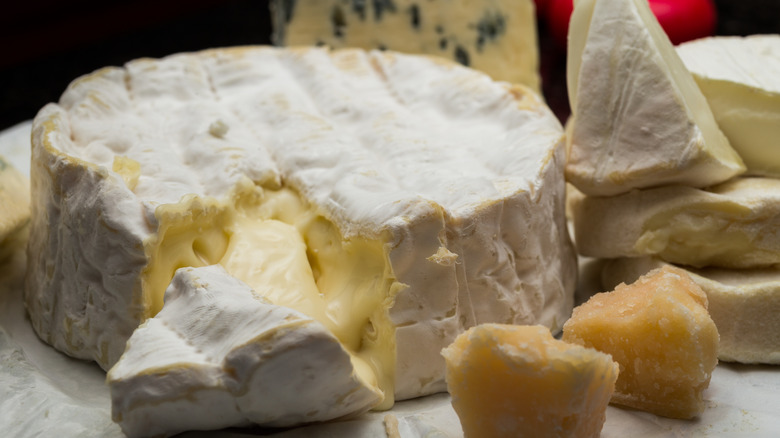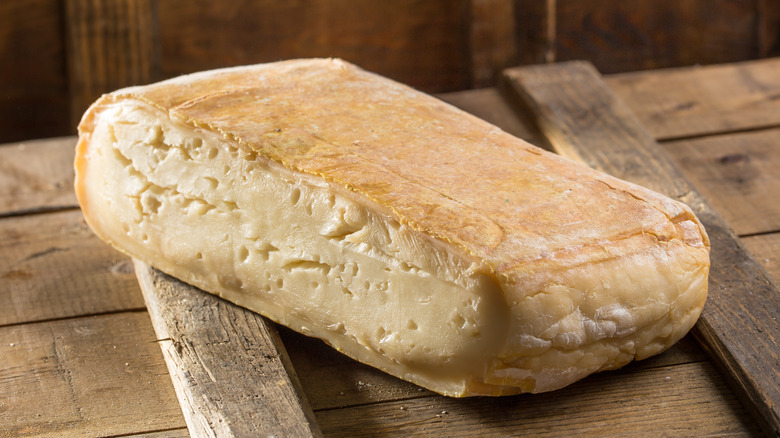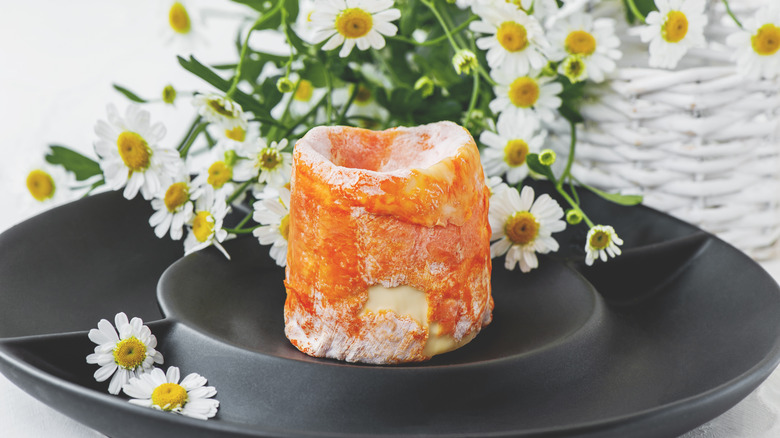For The Gooiest Cheeses, It's All About The Washed Rind
Cheese is a perplexing food. Why should the fermented, curdled (for all intents and purposes, spoiled) milk of another mammal species taste so delicious? Furthermore, why is it even better when it takes on such a moldy appearance and pungent odor that better judgment ought to send us running in the other direction? It's long been understood that some of the gnarliest-looking and -smelling cheeses are among the world's best-tasting: Limburger, Munster, Époisses (baptized in Burgundy wine, but allegedly banned from public transit in France, per BravoTV) ... there's even Meadow Creek Grayson, produced by the Feete family (which according to Insider smells not like their surname, but rather like beef broth and soil after a downpour).
According to Cheese.com, monks in the north of France created washed rind cheeses specifically for their savory, meat-like flavors. Their aromas have been compared to feet, barnyards, farm animals, and ammonia, and their flavors can be mild, grassy, herbal, sweet, salty, and much more. Cook's Illustrated describes them as buttery, gamey, and fungal — generally much gentler on the tongue than on the nose. Some of them are also known to become melty puddles of deliciousness over time. So what in the world is going on with these smelly cheeses?
How are washed rind cheeses made?
According to Insider, the so-called washed rind cheeses are rubbed with brine, cultures, wine, or beer for extra fun. As a chapter in Cheese Problems Solved explains, this "smearing" process causes B. linens bacteria to proliferate on the exterior of the cheese, which out-compete undesired microorganisms and result in the signature strong odors and paradoxically delicate flavors of this (in)famous family of cheeses. It gives the cheeses pinkish-orange coloration and slightly sticky, but not slimy, exterior that may contain crunchy salt crystals leftover from their brines, Culture Cheese Mag writes. Many raw milk-washed rind cheeses are illegal in the United States.
As Wisconsin Cheese explains, the edible washed rind that naturally develops is similar to a bread crust and shouldn't be skipped by cheese purists. But perhaps the most enticing thing about washed rind cheeses is their creamy, oozy quality that develops with age and temperature. This comes from the natural molds and yeasts transforming the cheese's fats and proteins — ripening the cheese from the outside in, according to Saxelby Cheese. The blog explains that you can see this in action when the rubbery outer rind begins to separate from the gooey interior of the cheese.
How to serve (and preserve) stinky cheese
If you're ready to dive into the fascinating world of washed rind cheese, consider salty Italian Taleggio a good entry point and try it in something familiar and comforting, like gooey, creamy mac and cheese. Try a washed rind-style blue like gorgonzola in blue cheese, pesto, and mushroom appetizers, or make your own homemade blue cheese dressing. Or simply enjoy washed rind cheese for its own sake, like classy Langres whose caved-in top is allegedly intended to be filled with champagne (per Culture). If you're intrepid, Stinking Bishop by Charles Martell & Son and Jasper Hill's spruce bark-wrapped Winnimere are some singularly smelly, spectacular cheeses. Chef Daniel Humm of "world's best restaurant" Eleven Madison Park likes Hooligan by Cato Corner Farm, according to Bloomberg.
Academy of Cheese explains that all cheese should be brought to room temperature before eating — otherwise you'll miss out on the unique flavors and textures you're after. It'd be a shame to endure the smell for nothing! Cook's Illustrated implores cheese lovers to ideally store washed rind cheeses in airtight glass containers to prevent their most famous trait from permeating the fridge, and enjoying them within a week.


